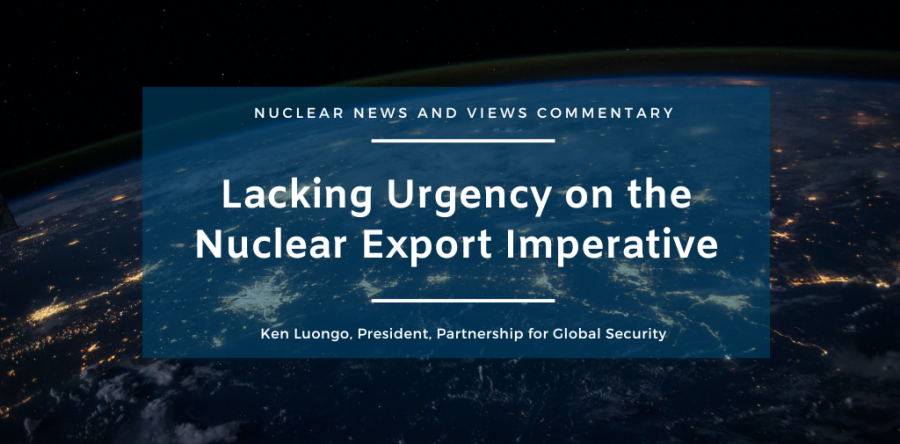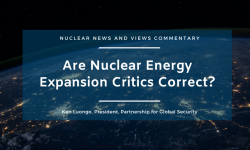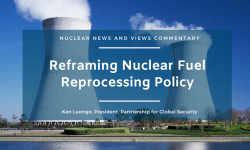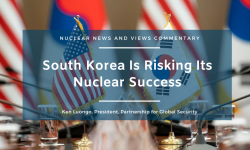Last week the Washington Post published that Russia’s state-owned nuclear company, Rosatom, was supplying conventional weapons materials to support the war in Ukraine.
The article created alarm about the role of a civil nuclear enterprise aiding the Russian war effort. That, in addition to its activities at the Ukrainian nuclear plant at Zaporizhzhia, may lead to the first sanctions against Rosatom, weakening its position as the world’s leader nuclear exporter.
But the U.S. and its democratic allies are not prepared to supplant Russia as the major supplier of international nuclear technologies and fuel and won’t be unless they quickly shift gears.
Coincident with the Post piece, the Nuclear Innovation Alliance published a new report making recommendations for how to transform the U.S. Department of Energy from an incubator of new nuclear power reactors to a driver of their commercialization and export.
However, NIA’s recommended bureaucratic conversion is likely mission impossible because the U.S. administration is convinced it already is on top of the job. The DoE response to the report’s useful recommendations was particularly vacuous and illustrated the prevailing wave-off of clear deficiencies.
That is a dangerous delusion. There are serious policy and technology gaps, insufficient government-wide coordination, and an inability to effectively survey and target the global nuclear market.
The NIA recommendations covered three critical areas: creating a strategic plan, effectively commercializing technologies, and integrating activities across the federal government. Another area could have been added – preparing the global market for advanced reactors.
The NIA recommendations called for connecting various DoE offices in support of an advanced nuclear energy “Earthshot”. This approach would fuse together the capabilities of the department’s clean energy, national laboratory, and technology demonstration sectors in support of a “comprehensive national strategy for exporting advanced nuclear energy”.
Creating an advanced nuclear energy strategic plan should be a no-brainer. But it isn’t even under consideration in the U.S. government.
A second issue area the report identified was improving the commercialization capabilities of DoE. The recommendations included hiring more business-knowledgeable staff, targeting funding to ensure technological progress, and supporting the supply chain and testing facilities necessary for commercial success.
There seems to be some acknowledgement that these suggestions are needed within the department. But it is too fragmented to organize itself to improve its performance along these lines.
Further, there are problems beyond DoE’s control on the path to commercialization. As the Breakthrough Institute continues to hammer away at, the Nuclear Regulatory Commission is creating commercialization roadblocks for advanced reactors in its new draft regulations.
The third issue on which NIA offered its recommendations was the necessary effort to organize the “whole of government” on the advanced nuclear effort. The Congress already has identified the importance of having a senior White House official as the central coordinator for civil nuclear activities. NIA seconded that recommendation. But there is no discernable move in this direction.
The importance of that position is that it could combine the cacophonous component parts of the U.S. government that are addressing the advanced nuclear technology and policy issues into a more appealing bureaucratic concerto. It also would have the ability to identify and target gaps in the U.S. approach and underperforming areas.
One of those areas most in need of attention is the preparation of the global market for advanced reactors. The small size of these technologies makes them a potentially good fit with the needs of growing, climate-impacted, developing economy nations. But most of these countries are not ready for any kind of nuclear power deployment and need a significant support system.
The U.S., however, is not offering this deep level of support. It is over-relying in U.S. bilateral and multilateral summitry on the State Department’s FIRST program. This is a small, important, but ultimately insufficient program with a primary focus on slow capacity building. It also is cautious, awarding grants to organizations with which it has a history of cooperation, but which have little expertise in civil nuclear issues.
Traditional and time-consuming nuclear capacity building is insufficient for the opportunity and the needs of the next-generation nuclear energy market. The window of preparation is a decade or less. The U.S. also badly lags Russia and China in nuclear cooperation agreements in these countries and it hasn’t shown the willingness to embrace innovative approaches to small reactor market development.
It’s not clear what will motivate the administration to change direction. The U.S. seems completely unprepared to rapidly and effectively build the capabilities necessary to break the global nuclear dependency on Russia, even when that grip is in the process of being loosened.
Without a radical reckoning inside the energy department, other relevant agencies, and the White House, the current lack of urgency in aggressively shaping the international nuclear market will remain the default position. And that will sustain significant geopolitical, energy security, and national security liabilities.
Ken Luongo, President, Partnership for Global Security






